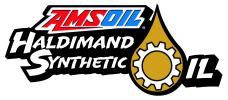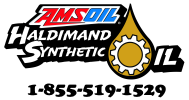
Synthetic Motorcycle Oil FAQS
Can AMSOIL motor oils be mixed with other brands?
YES. AMSOIL synthetic motor oils are compatible with other conventional and synthetic motor oils. Mixing AMSOIL motor oils with other oils, however, will shorten the oil’s life expectancy and reduce the performance benefits. AMSOIL does not support extended drain intervals where oils have been mixed. Mixing other oils with AMSOIL motor oils may also void the AMSOIL limited warranty.
What is the difference between synthetic and conventional oil?
Motor oil, whether synthetic or petroleum-based, consists of molecular chains of hydrogen and carbon atoms, referred to as hydrocarbons. Petroleum crude oil is a thick, highly flammable dark-brown or greenish liquid with high energy density. Many contaminating elements exist in this complex mixture of hydrocarbons, including sulfur, nitrogen, oxygen and metal components such as nickel or vanadium. Petroleum crude oil is the raw material used for a wide
variety of petrochemicals, including solvents, fertilizers, plastics and lubricants.
The oil refining process separates the various types of molecules in the oil by weight, resulting in a concentrated batch suitable for manufacturing products such as gasoline, LPG, kerosene or lubricant base oils. The chemical composition of conventional motor oil can vary substantially depending on the raw crude oil refining process.
While petroleum base oils are refined, synthetic base oils are manufactured and can achieve a higher performance level. Synthetic oil is chemically engineered for a certain molecular composition with a tailored and uniform structure. Such fine-tuned control over the final molecular composition of synthetic oils is the key to their superior performance properties. Designing molecular structures in a planned and orderly fashion results in molecules, and end-products, that are far more stable than their refined petroleum counterparts.
Are AMSOIL synthetic motorcycle oils wet-clutch compatible?
YES. AMSOIL synthetic motorcycle oils meet JASO MA2 friction requirements for use in wet-clutch applications.
Are AMSOIL synthetic motorcycle oils different from AMSOIL synthetic automotive oils?
YES. In addition to withstanding extreme pressure, protecting against rust and withstanding high temperatures, motorcycle oils must be compatible with wet clutches. AMSOIL synthetic motorcycle oils are designed to meet the unique frictional requirements necessary for wet-clutch compatibility and provide maximum protection and performance in these applications.
Can AMSOIL V-Twin products be used in shaft-drive applications that call for either a SAE 80 or SAE 90 fluid?
NO. Shaft-drive applications normally call for a fluid meeting the API Gl-4 or GL-5 service classification.
What AMSOIL motor oils are recommended for Harley-Davidson motorcycles?
AMSOIL 20W-50 Synthetic Motorcycle Oil and SAE 60 Synthetic Motorcycle Oil are the most commonly recommended oils for Harley-Davidson applications. Check the AMSOIL Motorcycle Product Lookup for specific recommendations.
What is the difference between Formula 4-Stroke® 10W-40 Synthetic Scooter Oil and 10W-40 Synthetic Motorcycle Oil?
AMSOIL 10W-40 Synthetic Motorcycle Oil (MCF) contains a robust additive package designed for the extreme pressures and high temperatures common in motorcycle applications. Its high TBN retention also makes it the appropriate choice for extended drain intervals. In scooter applications, Formula 4-Stroke 10W-40 Synthetic Scooter Oil (ASO) is the more economical choice.
What are the recommended AMSOIL transmission and primary chaincase lubricants for a Harley-Davidson Big Twin?
For the newer Big Twins, AMSOIL recommends 20W-50 Synthetic Motorcycle Oil (MCV) in the engine, transmission and primary chaincase. As secondary recommendations, Synthetic V-Twin Transmission Fluid (MVT) may be used in the transmission, and Synthetic V-Twin Primary Fluid (MVP) may be used in the primary chaincase. In older Harleys such as Knuckleheads, Panheads and Shovelheads, AMSOIL recommends SAE 60 Synthetic Motorcycle Oil (MCS).
What is the recommended AMSOIL transmission and primary chaincase lubricant for a Harley-Davidson Sportster?
AMSOIL recommends 20W-50 Synthetic Motorcycle Oil (MCV) for Harley-Davidson Sportster engines, transmissions and primary chaincases.
Is AMSOIL 20W-40 Synthetic V-Twin Motorcycle Oil catalytic-converter friendly?
YES. AMSOIL 20W-40 Synthetic Motorcycle Oil meets the physical requirements outlined in the API SM oil specification.
Is AMSOIL Synthetic Chaincase & Gear Oil (TCC) acceptable to use in the primary chaincase of a Harley-Davidson Big Twin?
NO. AMSOIL Synthetic Chaincase & Gear Oil does not have the correct viscosity for use in Harley-Davidson primary chaincases, and is not recommended for these applications. AMSOIL 20W-50 Synthetic Motorcycle Oil (MCV) is the primary recommendation for Harley- Davidson primary chaincases. The secondary recommendation is AMSOIL Synthetic V-Twin Primary Fluid (MVP).
What is the recommended AMSOIL lubricant for Victory and 2013 and newer Indian motorcycles?
AMSOIL recommends 20W-40 Synthetic V-Twin Motorcycle Oil (MVI) for all Victory and 2013 and newer Indian motorcycles, excluding the Scout which requires 15W-60 Synthetic V-Twin Motorcycle Oil (MSV).
What is the oil change interval for AMSOIL synthetic motorcycle oils?
AMSOIL synthetic motorcycle oils are engineered to provide outstanding protection for up to twice the manufacturer’s recommended change interval or one year, whichever comes first. Unless using an AMSOIL Ea Motorcycle Oil Filter, change the filter based on the manufacturer’s recommended interval. For Big Twin Harley-Davidson transmissions, follow the Harley-Davidson recommended drain interval for synthetic oil up to 20,000 miles or one year, whichever comes first.
What is the viscosity of AMSOIL Synthetic V-Twin Primary Fluid?
Synthetic V-Twin Primary Fluid has the physical characteristics of an SAE 50 motor oil. This does not mean it can be used in engines - it is merely a universally understood reference to its viscosity. Do NOT use Synthetic V-Twin Primary Fluid in the engine or transmission.
What is the viscosity of AMSOIL Synthetic V-Twin Transmission Fluid?
Synthetic V-Twin Transmission Fluid has the physical characteristics of an 110-weight gear lube. Although it has the properties of a gear lube, it is NOT a specification-rated gear lube. Do NOT use Synthetic V-Twin Transmission Fluid in the engine or primary chaincase.
Why does AMSOIL offer more than one viscosity motorcycle oil?
AMSOIL offers motorcycle oils in different viscosities to accommodate the differences between motorcycle models and manufacturers. Just as in automotive applications, motorcycle engines require specific oil viscosities for optimal performance and protection based on the components and tolerances in the engine.





 Canada
Canada United States
United States